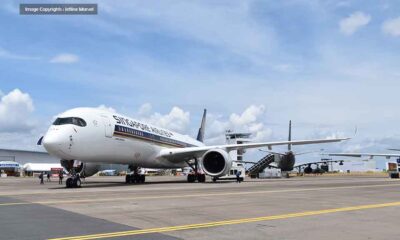Aviation
10 new planes you may fly soon in 2018 – 19

10 new planes you may fly soon in 2018 – 19
The Upcoming year would be filled with more Excitement because Aviation Fans may gone get to see and experience new aircraft in Airport. There are various manufacturers who are building advanced passenger aircraft which is likely to introduce in the Airliner Family very soon and some are very new to this segments like Chinese first Comac C919 and Russian First MC 21. But the competition is already built by Airbus and Boeing. In future Airliner Companies will have more option to choose various types and version aircraft for their Passengers Transport services. It also causes to the huge market changes for the respective country. Lets have glimpse of Aircraft which likely to introduce in upcoming year.
Comac C919 – China
It is a short-medium range commercial trunk liner that can claim indigenous intellectual property. Its all-economy class layout entails 168 seats, and the hybrid class layout 156 seats. The basic version is designed to cover a range of 4,075 km, while the enhanced version can stretch to 5,555 km. The C919 is designed to compete with the Airbus 320 and the Boeing 737, single-aisle planes that are the workhorses of the world’s airlines. For Comac, the plane represents the culmination of decades of work; for Airbus and Boeing, it is a challenge to a profitable duopoly that has endured for decades.
It rolled out on 2 November 2015 and first flew on 5 May 2017, for a planned introduction in 2020.
Mitsubishi Regional Jet – Japan
The Mitsubishi Regional Jet or MRJ for short, is a twin-engine regional jet aircraft seating 70–90 passengers manufactured by Mitsubishi Aircraft Corporation, a partnership between majority owner Mitsubishi Heavy Industries and Toyota Motor Corporation with design assistance from Toyota affiliate Fuji Heavy Industries, already a manufacturer of aircraft. It will be the first airliner designed and produced in Japan since the NAMC of the 1960s, which was produced at a loss. Its first flight was in November 2015.After a fifth delay, deliveries are scheduled to start by mid-2020.
MC 21 – Russia
The first MC-21-300 rolled-out on June 8, 2016 and first flew on May 28, 2017. It has a carbon fiber reinforced polymer wing and is powered by Pratt & Whitney PW1000G or Aviadvigatel PD-14 turbofans. With a capacity of 132-163 passengers in two class, up to 165-211 and up to 6,000–6,400 km (3,200–3,500 nmi) range, the standard MC-21-300 will be followed by a shortened MC-21-200. It has 175 orders as of June 2016.The initial design started in 2006 and detailed design was ongoing in 2011, after delaying introduction from 2012 to 2020
Boeing – United States
Boeing 737 Max – 9
First flight is the latest step in the airplane’s thorough flight-test program, which will be followed by first delivery in 2018. On first flight, teams performed tests on flight controls, systems and handling qualities. The 737 MAX 9 will now undergo comprehensive flight testing before customer deliveries start in 2018.The 737 MAX 9 debuted to the world on March 7. Since then, teams have been performing systems checks, fueling and engine runs on the flight line in preparation for first flight.
Boeing 737 Max – 10
The 737 MAX 10 will be the airlines’ most profitable single-aisle airplane, offering the lowest seat costs ever. Like Boeing’s other 737 MAX models, the MAX 10 incorporates the latest technology CFM International LEAP-1B engines, Advanced Technology winglets, Boeing Sky Interior, large flight deck displays, and other improvements to deliver the highest efficiency, reliability and passenger comfort in the single-aisle market.
Wide market acceptance with 361 orders, commitments from 16 customers. The 737 MAX is the fastest-selling airplane in Boeing history. The first MAX variant, the 737 MAX 8 has entered commercial service and will followed by the MAX 9, MAX 7 and the MAX 10, which will be introduced in the 2020 time frame.
Boeing 787 -Dreamliner 10
The 787-10 Dreamliner is the newest and longest member of the super-efficient 787 family. As a stretch of the 787-9, the 787-10 leverages the family’s proven technology, long range and preferred passenger experience, with unprecedented efficiency: 10 percent better fuel and emissions than the best on offer by the competition and 25 percent better than the airplanes it will replace.
The first test aircraft is engaged in flight envelope expansion work and the second joined the program in early May 2017, while the third with a passenger cabin interior to test the uprated environmental control system and Trent fuel-burn performance should join in June. The −10 will appear at the 2017 Paris Air Show and it will be first delivered to launch customer Singapore Airlines early in 2018
Airbus – Europe
A350-1000
The A350 XWB is truly innovative; introducing new technology throughout the entirety of the aircraft. From the design of the wings that morph and change shape in-flight to obtain optimal efficiency, to the flight controls and system that reduce the pilot’s workload, this aircraft utilizes modern technology to create a better way of flying.
Nowhere is this innovation more apparent than in the A350 XWB’s fuselage, built with carbon-fibre reinforced plastic (CFRP). The combination of these technological advances ensures that the A350-1000 burns 25 per cent less fuel than its nearest competitor, saving money and reducing any harmful effects to the environment. A350-1000 expected to be launch on 2018-19.
A319 neo
The A320neo “new engine option” is the latest of many product upgrades as Airbus continues to invest around 300 million euros a year in improvements for the A320 Family. Delivered to its first airline operator in 2016, the NEO incorporates many innovations, including latest generation engine choices – the PurePower PW1100G-JM from Pratt & Whitney and CFM International’s LEAP-1A – and large Sharklet™ wingtip devices, which together deliver 15 per cent in fuel savings.
Thanks to optimised use of cabin space, the A319neo – which performed its first flight in March 2017 – seats 140 passengers in two classes or up to 160 in a high-density layout with a range of up to 3,750 nautical miles.
https://jetlinemarvel.net/2018/04/14/top-10-longest-flights-in-the-world-2018/

Aviation
South Korea Introduces Cutting-Edge MRO Center for F-35 and IAI

South Korea is set to make waves in the aerospace industry with the establishment of a cutting-edge Maintenance, Repair, and Overhaul (MRO) hub for F-35 fighter jets and IAI (Israel Aerospace Industries) aircraft.
Central to this initiative is the specialization in converting Boeing 777-ERSF, colloquially known as the “Big Twin,” from passenger to freighter configurations. Under the terms of the agreement, IAI will spearhead the conversion of six B777-300ER and B777-200LR aircraft annually, commencing in 2024. This strategic move is in response to the anticipated surge in demand for wide-body freighter aircraft capable of long-haul flights.
Furthermore, South Korea’s forward-looking vision extends beyond aircraft conversion, with plans to establish a Lockheed Martin F-35 maintenance, repair, and overhaul depot at Cheongju Air Base by 2027. This strategic move not only enhances the operational readiness of South Korea’s air force but also positions the nation as a regional hub for F-35 maintenance expertise.
In preparation for this expansion, thirty Republic of Korea Air Force (ROKAF) engineers and technicians are slated to undergo intensive maintenance training in the United States in 2025, a testament to South Korea’s commitment to fostering local expertise and talent.
IAI’s visionary approach to certification and collaboration underscores the potential for transformative change. With plans for the 777-300ERSF certification process set to unfold in Israel, followed by the rigorous scrutiny of regulatory agencies such as the US Federal Aviation Administration (FAA), the stage is set for the ‘Big Twin’ to soar to new heights of success.
In partnership with esteemed entities like STK and Incheon International Airport Corporation, this collaboration promises to unleash a wave of benefits, amplifying the resilience and competitiveness of the Korean aviation sector while catalyzing job creation and economic prosperity.
Aviation
Lockheed Martin Expresses Interest in Joining AMCA Project

Lockheed Martin, a leading global aerospace and defense company, is demonstrating its dedication to strengthening collaborations with India’s research, industry, and academic sectors. With its rich experience in the aerospace industry and renowned for building some of the world’s most advanced jets, Lockheed Martin is now exploring opportunities to contribute to India’s aerospace sector, potentially providing a significant boost to aerospace technology in the country.
Randy Howard, Vice President of Global Pursuits at Lockheed Martin Aeronautics, recently underscored their interest in exploring “advanced transfer of technology opportunities” with Indian partners, signaling a proactive approach towards fostering technological exchange and advancement in the aerospace domain.
India has been at the forefront of fighter jet development since the 1970s, having produced its own cost-effective fighter jets and combat helicopters, while continually upgrading to maintain competitiveness on a global scale.
Lockheed Martin stands as a dominant force in the aircraft industry, renowned for developing cutting-edge planes like the F35 and F22, some of the most advanced fighter jets globally. They’ve also contributed to projects like the South Korean KF21 aircraft for defense purposes through collaborations.
Now, Lockheed Martin has set its sights on India’s defense sector manufacturing processes, expressing interest in partnering with India on its most anticipated project, the Advanced Medium Combat Aircraft (AMCA), likely to be a 5th generation fighter jet for the Indian military.
Their proposed collaboration could involve a spectrum of advanced technologies, including the Auto Ground Collision Avoidance System (Auto GCAS), a life-saving technology that intervenes to prevent ground collisions, thus significantly enhancing flight safety for Indian pilots.
Lockheed Martin is extending its expertise to design and develop an indigenous cockpit for the F-21 fighter jets, which India is procuring. This collaboration with Tata also includes the development of fighter jet wings. Established in 2023, this partnership adopts a “Ground Floor Design” strategy aimed at equipping India with an in-depth comprehension of 5th-generation cockpit technology and Man-Machine Interface (MMI) systems.
As India’s Fighter jet program advances with finalized aircraft frame and engine prototypes, Lockheed Martin has expressed interest in joining the project. They see a groundbreaking opportunity in cooperative 5th Generation Fighter Development, potentially expediting the AMCA program’s progress through technology and expertise sharing.
Furthermore, Lockheed Martin is keen on collaborating on large-wing, jet-powered UAV platforms, which could enhance India’s unmanned aerial capabilities.
While discussions are ongoing, and specific collaboration details await finalization, this initiative represents a potentially transformative stride in India’s aerospace self-reliance journey and Lockheed Martin’s strategic engagement with the Indian market.
Aviation
Can Airline Seat Cushions Be Used As Life Jackets?

In the event of an aircraft ditching into water, there’s a common question: Can aircraft seats serve as an alternative to life jackets for flotation? The answer lies in understanding their respective functions.
While seat cushions can provide some buoyancy in water, they are not intended nor certified to function as life jackets. Their primary purpose is to offer cushioning for passengers during flight. On the other hand, life jackets are meticulously engineered to keep individuals afloat in water, equipped with buoyancy materials, secure straps, and reflective elements for visibility. They offer numerous advantages over mere cushions.
While a seat cushion might offer temporary assistance in staying afloat, it’s not a dependable substitute for a proper life jacket during an emergency. It’s crucial to utilize approved safety equipment when near bodies of water. A life jacket, designed to keep a person buoyant for extended periods, offers the rigidity needed for prolonged flotation and allows for easy movement of the arms to navigate effectively.
What fabric is used in aircraft seats?
Seats are meticulously designed to fulfill multiple purposes, ensuring passenger comfort, safety, and protection from unforeseen circumstances like fires and accidents. A typical design incorporates an aluminum frame with blocks of polyurethane foam affixed to it. Additionally, a layer of fire-resistant fabric, such as Kevlar or Nomex, is often applied over this framework, topped with a layer of cloth or leather.
Leather seats, while luxurious, are more expensive compared to traditional cloth seats. The majority of fabrics used in seat upholstery contain at least 90% wool fiber, with the remainder typically consisting of polyamide (nylon). Wool stands out as the primary fiber chosen for commercial airline seating fabric due to its desirable properties and suitability for such applications.
What is the lightest economy seat?
In recent times, airlines have been downsizing seat dimensions to accommodate more passengers, resulting in reduced cushion length and leg space. This contrasts with earlier times when airlines offered more generously cushioned seats and ample amenities.
According to Recaro Seats Company, their SL3710 model represents the lightest economy class seat available, weighing in at a mere 8 kg (17.6 lb.), setting a new standard in aircraft seating.
For individuals weighing more than 350 pounds, fitting into a standard economy-class seat can be a challenge due to the narrower dimensions. Economy seats, also referred to as “coach,” “standard,” or “main cabin” seats, typically range from about 40 to 48 centimeters in width, further emphasizing the need for more accommodating seating options.



























